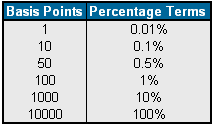A place for you to learn about some powerful financial concepts and products that will greatly enhance your life. To subscribe, enter your email address below.
Thursday, 12 January 2012
What is a Basis Point?
Mortgage people tend to speak in their own lingo to a client, and sometimes that client isn't really understanding what is being said. One of the most common 'lingo' terms that a mortgage broker will use is Basis Points or BPS (called beeps). Below is a short, but comprehensive, explanation of what a Basis Point is and how it applies to mortgages and various investment vehicles.
A basis point is a unit of measure used in finance to describe the percentage change in the value or rate of a financial instrument. One basis point is equivalent to 0.01% (1/100th of a percent) or 0.0001 in decimal form. In most cases, it refers to changes in interest rates and bond yields.
For example, if the Federal Reserve Board raises interest rates by 25 basis points, it means that rates have risen by 0.25% percentage points. If rates were at 2.50%, and the Fed raised them by 0.25%, or 25 basis points, the new interest rate would be 2.75%.
In the bond market, a basis point is used to refer to the yield that a bond pays to the investor. For example, if a bond yield moves from 7.45% to 7.65%, it is said to have risen 20 basis points.
The usage of the basis point measure is primarily used in respect to yields and interest rates, but it may also be used to refer to the percentage change in the value of an asset such as a stock. It may be heard that a stock index moved up 134 basis points in the day's trading. This represents a 1.34% increase in the value of the index.
Examine the chart:
The easiest way to convert basis points into a percent form is by simply taking the amount of basis points and multiply by 0.0001 which will give the percent in decimal form. So if you have to convert 384 basis points into a percent, simply multiply 384 by 0.0001. This will give you 0.0384 which is 3.84% (0.0384 x 100).
This can also be done in reverse to find out the number of basis points that a percent represents by dividing the percent (in decimal form) by 0.0001. For example, say the rate on a bond has risen 2.42%, simply take 0.0242 (2.42% / 100) and divide by 0.0001 to get 242 basis points.
Source: investopedia.com
